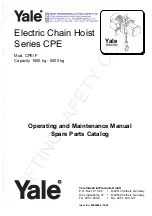
9
CPA operating instructions
5. FuNCTION CHECK AFTER INSTALLATION
Note:
Before operation of the hoist, the plug (Fig. 14, 27) on the gearbox
housing must be replaced by the vent included in the supply.
Prior to putting the hoist into service for the first time after assembly,
grease the trolley gear wheels (geared trolley, air trolley) and lubricate
the load chain when it is not under load (see page 10).
Before the chain hoist is put into regular service, the following checks
must also be made:
• Have all fastening screws on the hook, chain stop, hoist and trolley
been tightened? For tightening torques, see maintenance instructions.
• Have the end stops been fitted on the crane runway?
• Has the chain been appropriately reeved in the chain drive?
• The chain stop must always be correctly fitted to the loose end of the
load chain (idle fall).
• All units with two chain falls must be inspected before initial operation
to ensure that the load chain is not twisted or kinked. The chains of
two fall hoists may become twisted if the bottom block is rolled over,
for example.
• Perform an operating cycle without load. The chain must move evenly
and smoothly.
• Check the brake function with rated load for lifting and lowering.
• For trolleys, travel the complete travel distance without load. The
clearance between the trolley wheel and the beam flange must be
between 2 and 4 mm on each side. Check the position of the end
stops in the end positions of the runway.
6. PuTTING INTO SERvICE
Inspection before initial operation
All hoists must be inspected prior to initial operation by a competent
person, any defects must be eliminated. The inspection mainly consists of
a visual inspection and a function check. These inspections are intended
to establish that the unit is in a safe condition and that any defects and
damage, e. g. caused by inappropriate handling during transport or
storage, are detected and eliminated.
Competent persons may be, for example, the maintenance engineers
of the manufacturers or the suppliers. However, the company may also
assign performance of the inspection to its own appropriately trained
specialist personnel. The inspections have to be initiated by the operat-
ing company.
Inspection by an authorized crane expert engineer
If the hoist is used as a crane, an acceptance test has to be carried out
by an authorized crane expert engineer prior to initial operation. This
test has to be documented in the crane test and inspection booklet.
The operating company must arrange for an authorized crane expert
engineer to carry out the test.
7. OPERATION
Installation, maintenance, operation
Only persons who are familiar with the units must be entrusted with
installation, maintenance or independent operation of the hoists.
They must have been appointed for installation, maintenance or opera-
tion of the hoists by the operating company. Furthermore, the operator
must be familiar with the relevant accident prevention regulations (UVV).
Checks before starting work
Before starting work, always inspect the hoist including the load support-
ing devices, equipment and load-bearing construction for visual defects
and/or faults. In addition, test the brake and check that the hoist and
the load are correctly attached. To do this, carry out a short work cycle
of lifting/pulling and/or loading/unloading. The selection and calcula-
tion of the proper load-bearing construction are the responsibility of the
operating company.
Inspection of the load chain
Inspect the load chain for sufficient lubrication and check for external
defects, deformations, superficial cracks, wear or signs of corrosion.
Inspection of the chain stop
Chain stops must always be fitted to the loose end of the load chain
(idle fall) (Fig. 10.)
Inspection of the chain reeving
All hoists with two or more chain falls must be inspected before initial
operation to ensure that the load chain is not twisted or kinked. The
chains of two fall hoists may become twisted if the bottom block is rolled
over, for example, (Fig. 15, 16).
Inspection of the suspension and load hooks
Inspect suspension and load hooks for deformations, damage, cracks,
wear or signs of corrosion.
Suspending the load
The load must always be seated in the centre of the hook. Never at-
tach the load to the tip of the hook (Fig. 17). This also applies for the
suspension hook.
Inspection of the crossbar (for trolleys)
Inspect crossbars for correct assembly and visually check for external
defects, deformations, cracks, wear and signs of corrosion. In particu-
lar check for correct assembly of the spring pins (only for CPA 2-31/
5-17/10-9).
Checking the trolley width adjustment
For a chain hoist with trolley, the specified values must be maintained
on each side between the trolley wheel flanges and the outer beam edge
(see page 7, Fig. 13). Enlarging the adjusted trolley width, e. g. to enable
the trolley to negotiate smaller curve radii, is forbidden.
Travelling the hoist
Push-type trolley
By pushing the attached unit (e.g. hoist) or the attached load.
Note:
Never pull on the air pressure hoses. Attached loads must only
be pushed.
Fig. 15
Fig. 17
Fig. 16
Correct!
Incorrect!
Fig. 14





























